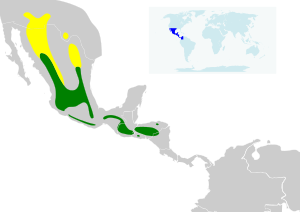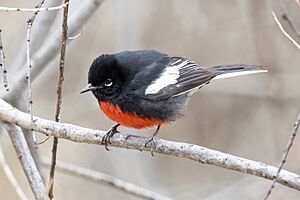Painted redstart facts for kids
Quick facts for kids Painted redstart |
|
|---|---|
 |
|
| Conservation status | |
| Scientific classification | |
| Genus: |
Myioborus
|
| Species: |
pictus
|
 |
|
| Range of M. pictus Breeding range Year-round range | |
| Synonyms | |
|
Setophaga pictus |
|
The painted redstart (Myioborus pictus) is a colorful bird found in the mountains of Central America. It's also sometimes called the painted whitestart. These birds are among the largest New World warblers, growing to about 6 inches (150 mm) long, including their tail.
Adult painted redstarts have shiny black feathers. They have bright white stripes on their wings and a striking red belly. Both male and female birds look very similar. A special thing about female painted redstarts is that they can sing just as beautifully as the males!
Contents
About the Painted Redstart's Name
When this bird was first described in 1829, a naturalist named William Swainson gave it a different scientific name. Later, scientists decided to move it to its current group, Myioborus. This was because it shared many features with other birds called whitestarts.
There are two slightly different types, or subspecies, of the painted redstart:
- M. p. pictus: You can find this type from the southern United States (like Arizona and New Mexico) down to parts of Mexico. Birds from the northern areas often travel south for the winter.
- M. p. guatemalae: This type lives from southern Mexico to northern Nicaragua. It has less white on its wing and tail feathers. These birds usually stay in the same area all year and do not migrate.
What Painted Redstarts Look Like
The painted redstart is the biggest bird in its group, Myioborus. It measures about 5.1–5.9 in (13–15 cm) long. Its wingspan is around 8.3 inches (21 cm), and it weighs about 0.3–0.4 oz (8.5–11.3 g).
Both male and female adult birds have the same feather colors. They are mostly black with a bright red lower chest and belly. They also have large white patches on their wings and white outer tail feathers. You can spot them by the white crescent shapes just under their eyes. Their bill and legs are black.
Young painted redstarts look different from adults. They don't have the bright red belly or the shiny black feathers. Instead, they are brownish-gray. Their belly and under-tail feathers are lighter, and their wing patches have a pale cream or yellow tint.
Their Unique Voice
Painted redstarts are special because female birds can sing just as well as males. This is quite unusual for birds, especially for warblers. In the spring, during courtship, a pair of painted redstarts will often sing together. This helps them form a strong bond.
Where Painted Redstarts Live
Painted redstarts are common in open oak forests and canyons. They live at high elevations, usually between 1,500–2,500 m (4,900–8,200 ft). Their home range stretches across Central America and Mexico. They can be found as far north as Arizona, New Mexico, and Big Bend National Park in Texas.
These birds mainly eat insects. In summer and winter, they might travel south, sometimes reaching Nicaragua. Occasionally, they are seen even further north than their usual range, like in California.
Reproduction and Nests
Painted redstarts build their nests on the ground. They hide their nests among rocks, roots, or clumps of grass. They prefer to build on steeply sloping ground to keep their nests safe.
Their nests are large and shallow. They are made from strips of bark, plant fibers, leaves, and grass. The female bird usually lays 3 or 4 eggs. The eggs are white or cream-colored and have small brown and reddish spots. The mother bird sits on the eggs for about 14 days until they hatch. Not much else is known about their nesting habits.
See also
 In Spanish: Candelita aliblanca para niños
In Spanish: Candelita aliblanca para niños



